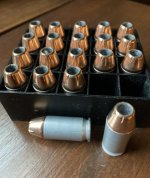cmj8591
Member
I know there's a lot floating around about reloading aluminum cases but I never did it and really never thought to do it. The other day I was going through some 9mm brass and came across some CCI, aluminum. I know that they used to prime them with Berdan primers but at some point, changed to Boxer style. Of course the ones I have are Boxer primed. I had my Dillon press set up for 9mm and I figured "what could be the harm?". Now if you're reading this and thinking "why", 9mm brass is available and cheep and manufacturers tell us not to and you might put an eye out, and you feel the need to tell me what a threat to humanity I am, have at it but that's not why I tried this little exercise. The only real reason I tried this was because the cases made an appearance and I was bored. As I said, the cases are CCI and have the NR mark on them. (Whatever could that mean?..wink, wink) They measured .390 just ahead of the web before sizing. My Lee sizing die brought them to .386. They entered the die without any hang up. I flared the mouth a little more than I wanted to but the die was set up and I didn't change it. After the first one, I thought that I would have to adjust the flare but I didn't and none of them cracked. I seated the bullet as usual and taper crimped with a Lee die. The loaded cases looked fine with just a bit of burnish from the sizing die.

Sorry for the focus. The load is 4.4 grains of Bullseye with a 115 grain plated bullet and a CCI standard primer. This is one of my usual range loads and always works well. It's not really close to maxing out but is relatively accurate in all of my 9's and functions well. I shot them in a Glock 45. It seems to have the least supported chamber of all of my 9's and it's a Glock so if it vaporizes, I won't feel so bad about it. The gun was dirty before I fired them and I didn't do anything special as far as lube was concerned. I shot the gun as is. The gun function flawlessly and the loads shot the same as the brass ones. The recovered cases had no cracks or bulges. They measured .390, the same as when I had started. There did seem to be a little bit of primer flow. This might be due to the fact that they seem to have bigger flash holes than the brass cases. I don't have pin gauges so I don't have measurements but visually they look bigger.

So what did this non scientific, anecdotal experiment accomplish? Not much, really! I do think that you could make a case that if you were shooting in a place where you can't recover your brass this might be useful. Other than that, it was more about "does this work?". The answer is, at least in my case, yes, it works pretty well. Do try this at home!

Sorry for the focus. The load is 4.4 grains of Bullseye with a 115 grain plated bullet and a CCI standard primer. This is one of my usual range loads and always works well. It's not really close to maxing out but is relatively accurate in all of my 9's and functions well. I shot them in a Glock 45. It seems to have the least supported chamber of all of my 9's and it's a Glock so if it vaporizes, I won't feel so bad about it. The gun was dirty before I fired them and I didn't do anything special as far as lube was concerned. I shot the gun as is. The gun function flawlessly and the loads shot the same as the brass ones. The recovered cases had no cracks or bulges. They measured .390, the same as when I had started. There did seem to be a little bit of primer flow. This might be due to the fact that they seem to have bigger flash holes than the brass cases. I don't have pin gauges so I don't have measurements but visually they look bigger.

So what did this non scientific, anecdotal experiment accomplish? Not much, really! I do think that you could make a case that if you were shooting in a place where you can't recover your brass this might be useful. Other than that, it was more about "does this work?". The answer is, at least in my case, yes, it works pretty well. Do try this at home!



